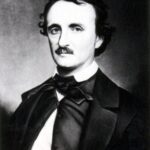Themes of poetry are vast, but two of the most common themes are love and death. These are topics that many people, not just poets, wonder about. There are many different ways to think of love and of death. Some people fear them, some embrace them. Others are indifferent; what happens, happens. The following three poems A Valediction: Forbidding Mourning, The Shape of Death, and Thirteenth Birthday all have the theme of love and death. However, they all have different takes on the subject. A Valediction: Forbidding Mourning states that the speakers love is so great that it can overcome death. The Shape of Death states the death brings fear, but that love can help overcome fear. And in Thirteenth Birthday, death is something to keep you from enjoying life.
John Donne’s A Valediction: Forbidding Mourning was written before Donne’s death in 1631, but was not published until after his death in 1633. Maybe this poem was a warning or advanced notice to his loved one of how to react when one of them died. Donne’s poem is about a couple who will be or is separated by death. The speaker of the poem believes that virtuous men, like him, will pass mildly and there is no need for tears or sorrow. A Valediction: Forbidding Mourning is written in a gentle, comforting tone. The speaker is going away, perhaps dying, but feels that his parting is not a separation but an “expansion” of the couple. This poem talks about the separation of two people who are soul mates. The speaker believes that even though he must go, it is for the best. “Though I must go, endure not yet/ A breach, but an expansion” (23 – 24).
The poem speaks of a great love, but the love must end abruptly. The word “valediction” in the title tells us that the poem is actually a farewell speech. The speech is being given to someone who is forbidden to mourn the loss of the speaker. The speaker believes that their union, their love, is strong enough to withstand a temporary separation. The speaker is not afraid of death, but believes that “virtuous men pass mildly away” (1). The speaker does not want his lover to scream and cry at his passing: “So let us melt, and make no noise,/ No tear-floods, nor sigh-tempests move;” (5 – 6). Instead, he wishes her to shed no tears and have no outbursts. This would show the “laity”, or laypeople, of their love. The speaker does not want others to know because he holds their love so sacred and special that no other should know of. To let others know of their love would be to make it unholy. The speaker tells us that changing lifestyles can bring harm and fear, but small changes can be a greater, more innocent experience. The speaker states that dull love, unlike his, can not handle the absence of their lover. When the lover is gone, part of the whole is missing: “Dull … lover’s love … cannot admit/ Absence, because it doth remove/ Those things which elemented it.” (13 – 16). The speaker goes on to say that this is not the situation that he and his lover are in. They have a love so refined that words can not describe it: “our selves know not what it is” (18). Because of their special bond, they do not need the reassurance of touch to love each other; they do not need to touch or hold hands or even see.
The speaker tells his love they their two souls form one soul, so she will not miss him. But then the speaker tells her that they really have two souls. One soul can not move without the other: “Thy soul, the fixed foot, makes not show/ To move, but doth, if th’ other do.” (27 – 28). The speaker then reminds his love of their firm bond and believes that he will soon come back to her. The speaker believes their love is something that will last forever; his parting will not change how they feel. The speaker’s departure will not be a breach of their love, but an expansion: “Though I must go, endure not yet/ A breach, but an expansion,” (22 – 23). The speaker also uses the metaphor “Like gold to airy thinness beat” to tell his woman that their love is like a gold ring, a circle; their love will always come back to where it started (24). The speaker uses metaphors in the poem: “Thy soul, the fixed foot, makes no show/ To move, but doth, if th’ other do.” (27 – 28). In this passage, the speaker is relating a soul to a foot. The speaker states that his soul could not go anywhere with out the soul of his love and that love will bring him back to where he began.
Another poem that speaks of love and death is May Swenson’s The Shape of Death. In this poem, death is looked at as something ugly. The speaker does not seem to know what exactly love is. The speaker of this poem tells us that “…Death is a cloud/ immense and awesome.” (2 – 3). Death comes when the lid is lifted from light. This is followed by a clap of sound. The death cloud “churns from white to gray/ like a monstrous brain that bursts and burns” (7 – 8). The “burning” of this death cloud leaves the living ashes of dread” (10). To this speaker, death is considered very bad. She believes that death is something that looms over us just to burn up and leaves us fearful. This speaker also speaks of love. She wonders if love is “a particle, a star” (17), if anyone will find love and if love is unattainable, past hope. Love is a much less known subject to this speaker. She is not really sure what love is but she knows that love is within each of us, “a secret motion of our air and blood.” (32). The speaker does know that love is something to keep us from the fear that death produces. She states that love is “a sheath to keep us pure of fear.” (35).
Yet another poem about love and death is Shelly Wagner’s Thirteenth Birthday. The speaker of this poem is very sad. She has suffered through the death of a child who would be thirteen today if he were alive. The speaker of this poem is the mother of the dead child. She is very upset by her loss. She thinks about the things that will not be: “There will be no party for my teenager” (3). She focuses on yard work that will keep up the appearance of the grave of her child. The speaker relates her life now to things that she did do with her dead child. For instance, she is thinking about raking the pin leaves and relates it to combing the tangles out of wet hair. Also, she says that she will put grass seed in a cart and “walk back and forth slowly as though strolling a baby carriage” (18 – 19). The speaker can not seem to get over her loss and everything she does reminds her of the past with a child. The speaker also thinks of going through the last of her child’s clothing in the attic. This leads her to think of the “leaves piling/ one upon another like children at recess;”(27 – 28). The speaker is very sorrowful. Her child has died and she can not move on with her life. Her love for her child makes everything that she does or thinks remind her of her child.
A three of these poems talk about love and death, but each of them differently. The speaker in A Valediction: Forbidding Mourning thinks that his love is so refined that nothing can keep him and his lover apart, not even death. In contrast, the speaker of The Shape of Death is not really sure what love is but believes that death is very bad. Death produces fear, but love can overcome or prevent that fear. In the last poem, Thirteenth Birthday, the speaker was so upset by the loss of her son that she could not move on with her life. Everything that she did reminded her of her son. Her love for him kept her from living her own life.
Works Cited
Wagner, Shelly. Thirteenth Birthday. Approaching Poetry. Peter Schakel and Jack Ridl.
New York:
St. Martin
‘s Press, 1997. 416-417.
Donne, John. A Valediction: Forbidding Mourning. Approaching Poetry. Peter Schakel
and Jack Ridl. New York:
St. Martin
‘s Press, 1997. 301-302.
Swenson May. The Shape of Death. Approaching Poetry. Peter Schakel and Jack Ridl.
New York:
St. Martin
‘s Press, 1997. 175-176.




